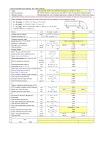

During welding, the pieces to be joined (the workpieces) are melted at the joining interface and usually a filler material is added to form a pool of molten material (the weld pool) that solidifies to become a strong joint.The intense welding heat and the sources employed to produce it can be potentially dangerous.Compressed gas cylinders are used in ship’s engine room and deck for a variety of repair and manufacturing operations. The two most used types of gas cylinders for this purpose are oxygen and acetylene.
 Therefore, to protect welders from injury and to protect building and equipment against fire, etc., a set of recommendations concerning safety and health measures for the welders and those concerned with the safety of the equipment’s etc., have been published by American Welding Society (AWS), Bureau of Indian Standards (BIS), Occupational Safety & Health Administration (OSHA) and many other International organizations.
Therefore, to protect welders from injury and to protect building and equipment against fire, etc., a set of recommendations concerning safety and health measures for the welders and those concerned with the safety of the equipment’s etc., have been published by American Welding Society (AWS), Bureau of Indian Standards (BIS), Occupational Safety & Health Administration (OSHA) and many other International organizations. When performing gas welding or cutting operation, following practical tips must be considered for safety and efficiency of operations and to avoid accidents while carrying out deck operations :-
Number 2 :- Welding technician should never hang a torch with its hose on regulators or cylinder valves.
Number 3 :- During gas weld working, if the welding tip becomes overheated it may be cooled by plunging the torch into water; close the acetylene valve but leave a little oxygen flowing.
Number 5 :- Never store oxygen and acetylene cylinder together in one space whenever possible. Keep them separately in well ventilated spaces. Ensure when not in use, their caps should always be on them.
Number 6 :- Always use the correct pressure regulators for a gas. Acetylene pressure regulator should never be used with any other gas.
Number 7 :- Do not move the cylinder by holding the pressure regulator and also handle pressure regulators carefully.
Number 8:- Control valves and fittings should be kept free of oil and grease. Never operate cylinder valves and parts with oily and greasy hands.
Number 9:- Open cylinder valves slowly to avoid straining the mechanism of the pressure regulator.
Number 11 :- Open and light acetylene first, then open and adjust oxygen to a neutral flame.
Number 12 :- For repairs, calibrations and adjustments purposes, the pressure regulators should be sent to the supplier.
Number 13 :- Do cracking before connecting pressure regulator to the gas cylinder.
Number 15 :- Close the acetylene torch valve first when shutting off the torch ( a "pop" might occur as the oxygen "blows out" the flame, but this eliminates the possibility of the flame burning up the acetylene line).
Number 16 :- When finished, close cylinder valves, bleed the lines to take pressure off regulators, neatly coil hoses and replace equipment.
Number 17 :- Never allow the hose to come into contact with oil or grease; these deteriorate the rubber and constitute a danger with oxygen.
Number 18 :- Use the correct color hose for oxygen (green/black) and acetylene gas (red); never use oxygen hose for acetylene or vice versa.
Number 19 :- Always protect the hose from being trampled on or run over. Avoid tangle and kinks. Never leave the hose so that it can be tripped over.
Number 20 :- Have a fire extinguisher easily accessible at the welding site.












0 Comments